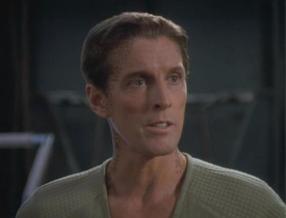Klingons
There were three major "versions" of Klingons:
- No cranial ridges, found in the original series
- Cranial Ridges "A", found in the first four movies
- Cranial Ridges "B", found in the later series and movies
There is no explanation for this shift found in the original series, any of the movies, or in The Next Generation. The first hints at retconning the disparity comes from the Deep Space 9 episode "Trials and Tribble-ations"—a pseudo-crossover episode with the orignal series—wherein Bashir, Odo, and O'Brien do not recognize a group of Klingons as such, and the following conversation takes place between them and Worf:
Worf: They are Klingons, and it is a long story.
O'Brien: What happened? Some kind of genetic engineering?
Bashir: A viral mutation?
Worf: We do not discuss it with outsiders.
This was left unaddressed until the Enterprise episodes "Affliction" and "Divergence", where the in-universe reason for why the original series Klingons lacked cranial ridges is established to be the side effect of genetic augmentation gone awry.
Given this, there are a few conjectures to explain the timeline of events between "Affliction" and The Next Generation:
The disparity between original series Klingons and the others is entirely imagined, and it was only a makeup issue. The original series Klingons should be imagined to have cranial ridges, and the Enterprise arc should be taken as a one-off about an unrelated issue. Supposedly, this was Gene Roddenberry's position (he obviously wasn't alive for the Enterprise arc, but reportedly rejected any attempts to explain the discrepancy while he was still working on Star Trek).
The affliction affected the entire Klingon species, but was eradicated either through genetic conditioning or breeding by the time The Next Generation occurs.
The affliction only affected part of the species, and the Enterprise in the original series happened to only encounter the subset of Klingons afflicted.
The disparity between the original series movies and the rest of Star Trek canon could then either be a period where the genetic problem was beginning to be corrected or when afflicted Klingons started to play around with cosmetic surgery.
Which theory is right has never been addressed on screen, but was, at least according to Enterprise writer Mike Sussman, intended to be left to the viewer to decide for themselves.
Trills
Like the Klingons, the change in makeup was done for aesthetic reasons:
Although Michael Westmore's alterations to make the Odan headpiece more feminine was as good as all of his work, the writers simply didn't like it. Apparently, after she had put on the Odan forehead appliance, someone looked at Terry Farrell and said to Westmore, "What did you do to her head, she used to be beautiful?" Instead of changing species, as they'd already come to like the idea of an "old man", a person with centuries of experience to guide Sisko, Westmore suggested to "just give her spots like we gave Famke", who played a Kriosian.
However, it was never addressed in canon: all Trill starting with Deep Space Nine have the Dax-style spots and the opportunity to explore the differences in-character à la "Trials and Tribble-ations" has never occurred on screen.





